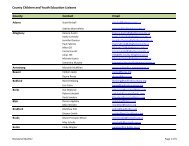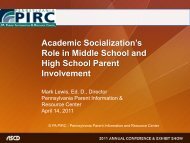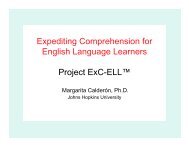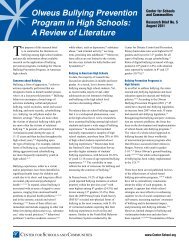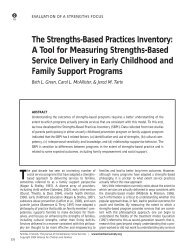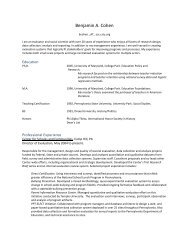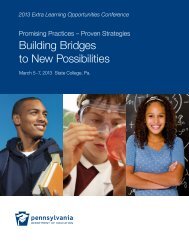The Achievement Gap - Mark Linkins - Center for Schools and ...
The Achievement Gap - Mark Linkins - Center for Schools and ...
The Achievement Gap - Mark Linkins - Center for Schools and ...
You also want an ePaper? Increase the reach of your titles
YUMPU automatically turns print PDFs into web optimized ePapers that Google loves.
Presenter Contact In<strong>for</strong>mation<br />
<strong>Mark</strong> <strong>Linkins</strong><br />
Coordinator of Curriculum<br />
Walling<strong>for</strong>d-Swarthmore School<br />
District<br />
Phone: 610-892<br />
892-3470 ext. 4701<br />
Email: marklinkins@yahoo.com
<strong>The</strong> <strong>Achievement</strong> <strong>Gap</strong><br />
<strong>Achievement</strong> <strong>Gap</strong>: State <strong>and</strong> Local<br />
Data<br />
Closing the <strong>Achievement</strong> <strong>Gap</strong>:<br />
Stories of Success<br />
Closing the <strong>Achievement</strong> <strong>Gap</strong>:<br />
Effective Strategies<br />
<strong>Mark</strong> <strong>Linkins</strong><br />
Copyright 2006
<strong>Achievement</strong> <strong>Gap</strong> Defined:<br />
<strong>Achievement</strong> disparity related to<br />
income:<br />
• Moderate <strong>and</strong> high income students<br />
consistently outper<strong>for</strong>m low income<br />
students<br />
<strong>Achievement</strong> disparity related to race/<br />
ethnicity:<br />
• Asian <strong>and</strong> white students consistently<br />
outper<strong>for</strong>m African American <strong>and</strong> Latino<br />
students
Pennsylvania’s <strong>Achievement</strong> <strong>Gap</strong><br />
PA’s gap parallels national trends<br />
Based upon a number of indicators,<br />
Pennsylvania’s gap is one of the most<br />
pronounced achievement gaps in the<br />
country
70<br />
60<br />
50<br />
PA <strong>Achievement</strong> Disparity: Income<br />
2004 PSSA Per<strong>for</strong>mance Levels<br />
Grade 11: Proficient <strong>and</strong> Above<br />
40<br />
30<br />
20<br />
All Students<br />
Low SES Students<br />
10<br />
0<br />
Reading<br />
Math
70<br />
PA <strong>Achievement</strong> Disparity: Race<br />
2004 PSSA Per<strong>for</strong>mance Levels<br />
Grade 11: Proficient <strong>and</strong> Above<br />
60<br />
50<br />
40<br />
30<br />
20<br />
White Students<br />
African American<br />
<strong>and</strong> Latino Students<br />
10<br />
0<br />
Reading<br />
Math
Pennsylvania High School<br />
Graduation Rates (2001)<br />
Percent Graduating in Four Years with<br />
a Regular Diploma<br />
100<br />
80<br />
60<br />
40<br />
20<br />
0<br />
83<br />
58<br />
49<br />
African American Latino White<br />
Source: Jay Greene <strong>and</strong> Greg Forster. Public High School Graduation <strong>and</strong> College Going Readiness<br />
Rates in the United States. <strong>The</strong> Manhattan Institute <strong>for</strong> Policy Research, September 2003.
6-Year Graduation Rate at<br />
Pennsylvania State University<br />
Graduation rate<br />
100<br />
80<br />
60<br />
40<br />
20<br />
60<br />
70<br />
82<br />
0<br />
African<br />
American<br />
Latino<br />
White<br />
Source: USDOE, Integrated Post-Secondary Education Data System, Graduation Rate Study.
Fifty years after Brown v.<br />
Board of Education,<br />
significant achievement<br />
disparities between rich<br />
<strong>and</strong> poor – <strong>and</strong> black <strong>and</strong><br />
white – persist. Why?...
Many say that low-income <strong>and</strong><br />
minority students have a difficult<br />
achieving time because …<br />
<strong>The</strong>ir parents are unable to provide<br />
adequate support at home.<br />
<strong>The</strong>y don’t have enough books at home.<br />
<strong>The</strong>y are more likely to come from single-<br />
parent homes.<br />
Etc…
Clearly, these socio-<br />
economic factors DO help<br />
to account <strong>for</strong> the<br />
achievement gap. To<br />
suggest otherwise would<br />
be naïve.
While such factors contribute to the<br />
achievement gap, what schools <strong>and</strong><br />
teachers do can serve to…<br />
maintain the gap<br />
exacerbate the gap<br />
minimize the gap
Parents may have the<br />
greatest impact on how<br />
their children come to us.<br />
But we have the greatest<br />
impact on how they<br />
leave us.<br />
North Carolina’s Supt. Of <strong>Schools</strong>
Research confirms that<br />
what schools <strong>and</strong><br />
districts do can<br />
dramatically alter<br />
achievement trends.
Two approaches to closing the gap…<br />
Targeted approach<br />
• Method: : Provide<br />
programs <strong>and</strong><br />
supports designed to<br />
address the specific<br />
needs of minority <strong>and</strong><br />
low SES students<br />
• Goal: : Boost minority<br />
<strong>and</strong> low SES<br />
academic<br />
achievement<br />
Universal approach<br />
• Method: : Implement<br />
comprehensive<br />
re<strong>for</strong>ms designed to<br />
“raise the bar” <strong>for</strong> all<br />
students (middle <strong>and</strong><br />
high achievers as well<br />
as low achievers)<br />
• Goal: : Boost academic<br />
per<strong>for</strong>mance <strong>for</strong> all<br />
students
A Tale of Two School<br />
Districts*…<br />
Philip’s Point School District,<br />
Indiana<br />
Noname School District,<br />
New York<br />
* School district names have been changed
Targeted Approach:<br />
Philip’s Point School District<br />
• Summer math program targeting minority students<br />
• Student mentoring program <strong>for</strong> African-American<br />
American<br />
students<br />
• Student mentoring program <strong>for</strong> Latino students<br />
• Extensive professional development opportunities <strong>for</strong><br />
faculty to explore relationship between<br />
race/ethnicity/class <strong>and</strong> academic achievement<br />
• Etc.
Universal Approach Combined with<br />
Targeted Initiatives:<br />
Noname School District<br />
• Detracking <strong>and</strong> “leveling up” all classes to<br />
honors level<br />
• Universal acceleration of math instruction<br />
• Providing adequate levels of in-class <strong>and</strong> out-<br />
of-class support so that all students can<br />
succeed in an academically challenging,<br />
honors-level classroom
Both schools have been<br />
implementing their<br />
respective approaches <strong>for</strong><br />
more than 15 years.<br />
What are the results?
Philip’s Point<br />
• Philip’s Point African-American American <strong>and</strong> Latino<br />
populations failed to make AYP in 2003-2004<br />
2004<br />
• Philip’s Point achievement gap is larger than<br />
state average<br />
• 2004 Passing Rates <strong>for</strong> State Reading <strong>and</strong><br />
Math Assessment<br />
Afr. Am. – approx. 30%<br />
White – approx. 90%
Noname<br />
• Minority enrollment in higher level math<br />
courses jumped from 3% to 40%<br />
• Percentage of minority students earning<br />
Regents diplomas jumped from 30% to 80%<br />
• Percentage of low SES students earning<br />
Regents diplomas jumped from 29% to 61%<br />
• Etc.
When schools employ data-driven<br />
driven<br />
initiatives to improve achievement <strong>for</strong><br />
ALL students, two things happen…<br />
Significant achievement gains <strong>for</strong> ALL<br />
students<br />
Disproportionately large gains <strong>for</strong> low<br />
income <strong>and</strong> minority students
Charlotte-Mecklenburg, North Carolina<br />
Raising <strong>Achievement</strong> <strong>and</strong> Closing <strong>Gap</strong>s<br />
Grade 3 Math<br />
100<br />
Percent Proficient<br />
80<br />
60<br />
40<br />
20<br />
40 point gap<br />
19 point gap<br />
African American<br />
Latino<br />
White<br />
0<br />
1998 1999 2000 2001 2002 2003<br />
Source: North Carolina Department of Public Instruction, http://www.ncpublicschools.org
Aldine, TX: Raising <strong>Achievement</strong><br />
<strong>for</strong> All While Narrowing <strong>Gap</strong>s<br />
Passing TAAS math test<br />
100%<br />
75%<br />
50%<br />
25%<br />
72%<br />
55%<br />
42%<br />
97%<br />
96%<br />
92%<br />
0%<br />
1994 1995 1996 1997 1998 1999 2000 2001 2002<br />
African American Latino White<br />
Source: Texas Education Agency-Academic Excellence Indicator System Report 1994 through 2002.
Massachusetts: Raising First-Attempt Pass<br />
Rates & Narrowing <strong>Gap</strong>s on High School<br />
Exit Exam<br />
% 10th Graders Passing MCAS<br />
English Exit Exam on First Attempt<br />
100%<br />
75%<br />
50%<br />
25%<br />
0%<br />
34%<br />
66%<br />
Latino<br />
+32<br />
40%<br />
75%<br />
African<br />
American<br />
+35<br />
73%<br />
94%<br />
White<br />
+21<br />
2000<br />
2003<br />
Source: Massachusetts Department of Education Web site.
Aligning curriculum <strong>and</strong> improving<br />
instruction benefits everyone, , but<br />
achievement gains are most<br />
dramatic <strong>for</strong> low income <strong>and</strong><br />
minority students.<br />
Why do such measures<br />
disproportionately impact this<br />
population?
While higher SES students<br />
glean intellectual <strong>and</strong> academic<br />
skills from their non-school<br />
environment, lower SES<br />
students are disproportionately<br />
dependent upon their school<br />
systems to provide them with<br />
the tools to achieve academic<br />
success.
<strong>The</strong>re<strong>for</strong>e…<br />
Any ineffective instruction or<br />
curricular gaps have a particularly<br />
negative impact on lower SES<br />
students.<br />
In contrast, higher SES students<br />
are better equipped to<br />
“compensate” <strong>for</strong> such deficiencies.
What classroom <strong>and</strong><br />
school practices serve<br />
to foster achievement<br />
<strong>for</strong> ALL students?
Multiple studies<br />
(Marzano et. al, 2001)<br />
have shown that the<br />
strategies listed on the<br />
following slide result in<br />
significant achievement gains<br />
<strong>for</strong> ALL students.
Questions, cues,<br />
advanced<br />
organizers<br />
Nonlinguistic<br />
representations<br />
Homework <strong>and</strong><br />
practice<br />
Rein<strong>for</strong>cing ef<strong>for</strong>t,<br />
providing praise<br />
Summarizing, note<br />
taking<br />
Setting objectives,<br />
providing feedback<br />
Comparing,<br />
contrasting,<br />
classifying<br />
Cooperative<br />
Learning<br />
Generating <strong>and</strong><br />
testing hypotheses
Two of these strategies, in<br />
particular, have been shown to<br />
improve achievement on<br />
st<strong>and</strong>ardized tests by up to 45<br />
percentile points.<br />
Which TWO strategies have<br />
been shown to produce such<br />
dramatic gains?
Questions, cues,<br />
advanced<br />
organizers<br />
Nonlinguistic<br />
representations<br />
Homework <strong>and</strong><br />
practice<br />
Rein<strong>for</strong>cing ef<strong>for</strong>t,<br />
providing praise<br />
Summarizing, note<br />
taking<br />
Setting objectives,<br />
providing feedback<br />
Comparing,<br />
contrasting,<br />
classifying<br />
Cooperative<br />
Learning<br />
Generating <strong>and</strong><br />
testing hypotheses
<strong>The</strong> answer is…<br />
Comparing, contrasting,<br />
classifying<br />
Summarizing <strong>and</strong> note<br />
taking
Identifying Similarities <strong>and</strong><br />
Differences:<br />
Most Effective Strategies<br />
Comparing<br />
Classifying<br />
Creating metaphors<br />
Creating analogies
<strong>The</strong> strategies that yield the<br />
greatest achievement gains <strong>for</strong><br />
ALL students – i.e. classification,<br />
comparison, creating metaphors,<br />
etc. - involve higher-level critical<br />
thinking skills.
This data contradicts the<br />
conventional wisdom that low-<br />
achieving students are best served<br />
by a program that focuses on a<br />
regimen of basic, rudimentary<br />
skills. Certainly these “basics” are<br />
crucial, but low-achieving students<br />
also need to engage in higher level<br />
learning.
Students in advanced classes are<br />
more likely to be asked to…<br />
Classify, compare, draw analogies<br />
Apply learning in a variety of contexts<br />
Connect learning to prior knowledge<br />
<strong>and</strong> personal experience
Students in the lowest-level level classes<br />
are more likely to be asked to…<br />
Engage in rudimentary skill <strong>and</strong> drill<br />
practices<br />
Learn facts in isolation<br />
Engage in rote memorization <strong>and</strong><br />
other practices devoid of context
In other words…<br />
Higher achieving<br />
students are more<br />
likely to be exposed<br />
to practices that are<br />
most effective in<br />
fostering critical<br />
thinking <strong>and</strong> boosting<br />
student achievement.<br />
Lower achieving<br />
students are more<br />
likely to be exposed<br />
to practices that fail to<br />
promote critical<br />
thinking <strong>and</strong> are<br />
there<strong>for</strong>e less likely to<br />
boost student<br />
achievement.
<strong>The</strong> primary source of<br />
variance in student<br />
learning is the quality of<br />
the assignments teachers<br />
provide to their students.<br />
Phillip Schlechty, 2001
Research confirms that<br />
lower achieving students<br />
are best served in<br />
classrooms that dem<strong>and</strong> a<br />
high level of intellectual<br />
rigor.
Research on Low Achieving Students<br />
(Marzano et. al, 2001) Indicates That…<br />
A majority of low-achieving students<br />
achieve at higher levels in college track<br />
classes than they do in low-level level classes<br />
Participating in a rigorous, college<br />
preparatory curriculum is the single<br />
greatest predictor of success in college<br />
AND in the workplace
To sum up…<br />
Demographics is not destiny: Many<br />
schools have employed data-driven<br />
driven<br />
initiatives that have dramatically<br />
reduced the size of their achievement<br />
gaps.<br />
Horizontal <strong>and</strong> vertical alignment of<br />
curriculum with st<strong>and</strong>ards is key to any<br />
successful ef<strong>for</strong>ts to close the<br />
achievement gap
Ef<strong>for</strong>ts to improve instruction <strong>and</strong><br />
curriculum benefit all students, , but<br />
disproportionately benefit minority<br />
<strong>and</strong> low-income students.<br />
Focusing on higher-level critical thinking<br />
skills – including classification,<br />
comparison, creating analogies, etc. – is<br />
essential to any ef<strong>for</strong>t to improve<br />
student per<strong>for</strong>mance.




